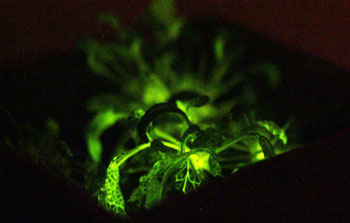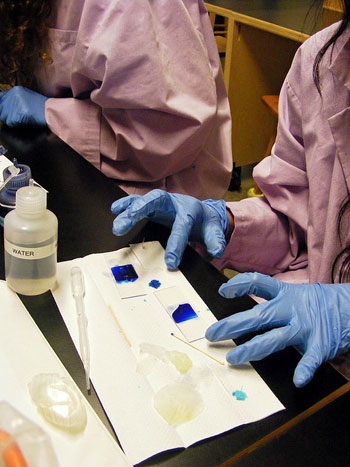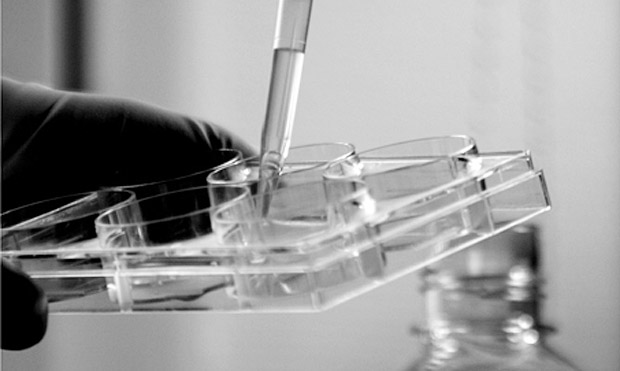Glen Martin
A commitment to biotech, in action
"I eat, breathe, live biotech,” says Ryan Bethencourt. “It’s really all I do at this point.”
This story is part of our ongoing exploration of synthetic biology and the DIYbio movement. Learn more by downloading a free edition of BioCoder.
Ryan Bethencourt seized his opportunity back in 2008. That made him an outlier: most people, after all, were seizing pink slips, not opportunities. But while the Great Recession wiped out billions in home equity and blew up companies by the score, it also freed up plenty of hard assets. In simple terms, you could buy a lot of expensive stuff for a song. And that’s just what Bethencourt and his pal, molecular biologist and fellow DIYbio enthusiast, John Schloendorn, did.
“The financial crisis resulted in the liquidation of a big chunk of the biotechnology sector,” says Bethencourt, a molecular geneticist-cum-biotech entrepreneur who was working as a business development director for a clinical research organization at the time. “So we bought up a lot of research-grade equipment. We felt we couldn’t afford to pass it up.” Read more…
Connecting the microcosmos and the macro world
Christina Agapakis explores the microbiological matrix that binds everything from pecorino to people.

Cheese from the Selfmade project.
This is part of our investigation into synthetic biology and bioengineering. For more, download the new BioCoder Fall 2014 issue here.
Good luck trying to jam Christina Agapakis into any kind of vocational box. Her CV cites disparate accomplishments as a scientist, writer, and artist — and teacher. Imparting highly technical information in a compelling, even revelatory way seems part of, well, her DNA. She can’t not do it. Moreover, her career arc represents a syncretic impulse that characterizes her general outlook on life.
“A friend is starting a group called Doctors without Disciplinary Borders, and I’m joining it,” says Agapakis. “It captures the spirit of my work pretty well.”
Agapakis is first and foremost a synthetic biologist and a microbiologist, but she’s not particularly happy with the way the synthetic biology narrative has played out. She thinks biocoding is inadequately explained by its practitioners and deeply misunderstood by the lay public, raising excessive expectations and misunderstandings about what synthetic biology can do. The discipline’s message would be better communicated, she believes, if metaphors grounded in biology rather than computers were employed. Read more…
A glowing trend
Glowing plants disrupt the GMO narrative.
 Editor’s note: this is an excerpt from the latest edition of BioCoder; it is republished here with permission. Get your free copy of BioCoder Fall 2014 here.
Editor’s note: this is an excerpt from the latest edition of BioCoder; it is republished here with permission. Get your free copy of BioCoder Fall 2014 here.
Unlike many of his generational peers, Glowing Plant chief scientific officer Kyle Taylor was never put off by genetically modified organism (GMO) crops. On the contrary: Kansas-born and bred, cutting-edge agriculture was as natural to him as the torrid summers and frigid winters of the southern plains.
“GMO corn first hit the market while I was still in high school,” says Taylor, “and I have to admit I was fascinated by it. It was Roundup resistant, meaning that it you could spray it with the most commonly used herbicide in commercial agriculture and it would remain unaffected. I found that really profound, a breakthrough.” Read more…
Looking for the next generation of biocoders
Natalie Kuldell on the hard work of bringing biocoding to the classroom.
 Synthetic biology is poised to change everything from energy development to food production to medicine — but there’s a bottleneck looming. How fast things develop depends on the number of people developing things. Let’s face it: there aren’t that many biocoders. Not in the universities, not in industry, not in the DIY sector. Not enough to change the world, at any rate. We have to ramp up.
Synthetic biology is poised to change everything from energy development to food production to medicine — but there’s a bottleneck looming. How fast things develop depends on the number of people developing things. Let’s face it: there aren’t that many biocoders. Not in the universities, not in industry, not in the DIY sector. Not enough to change the world, at any rate. We have to ramp up.
And that means we first must train teachers and define biocoding curricula. Not at the university level — try secondary, maybe even primary schools. That, of course, is a challenge. To get kids interested in synthetic biology, we have to do just that: get them interested. More to the point, get them jacked. Biocoding is incredibly exciting stuff, but that message isn’t getting across.
“Students think science and engineering is removed from daily life,” says Natalie Kuldell, an instructor of biological engineering at MIT. “We have to get them engaged, and connected to science and engineering — more specifically, bioengineering — in meaningful ways.”
Synthetic biology on the cusp
Oliver Medvedik on the grassroots future of biohacking and the problems with government overreach.
 Whither thou goest, synthetic biology? First, let’s put aside the dystopian scenarios of nasty modified viruses escaping from the fermentor Junior has jury-rigged in his bedroom lab. Designing virulent microbes is well beyond the expertise and budgets of homegrown biocoders.
Whither thou goest, synthetic biology? First, let’s put aside the dystopian scenarios of nasty modified viruses escaping from the fermentor Junior has jury-rigged in his bedroom lab. Designing virulent microbes is well beyond the expertise and budgets of homegrown biocoders.
“Moreover, it’s extremely difficult to ‘improve’ on the lethality of nature,” says Oliver Medvedik, a visiting assistant professor at The Cooper Union for the Advancement of Science and Art and the assistant director of the Maurice Kanbar Center for Biomedical Engineering. “The pathogens that already exist are more legitimate cause for worry.” Read more…
Most of what we need for smart cities already exists
Culture, play, and an emphasis on fair use will help smart cities take root.
The compelling thing about the emerging Internet of Things, says technologist Tom Armitage, is that you don’t need to reinvent the wheel — or the water and sewage systems, or the electrical and transportation grids. To a large degree, you can create massive connectivity by simple (well, relatively simple) augmentation.
“By overlaying existing infrastructure with intelligent software and sensors, you can turn it into something else and connect it to a larger system,” says Armitage. “Yes, you could simply design and construct an entirely new system, but that’s incredibly expensive, it would take a lot time, and you may lose some things (of cultural or architectural value) that you may want to save. It’s better to adapt existing systems to your goals if you have the technology to do it — and we have it.”
Armitage speaks from direct experience. He was one of the collaborators behind Hello Lamp Post, a 2013 Bristol, England, project aimed at engaging people on a deep and intimate level with the urban landscape. In conjunction with PAN Studio and media artist Gyorgyi Galik, Armitage designed software interfaces for Bristol’s “street furniture” — the eponymous lamp posts, of course, but also manholes, post boxes, telephone poles, traffic bollards, and trash cans. Read more…
The crowdfunding conundrum
Miscalculating funding thresholds can sink your startup.
There is widespread consensus that crowdfunding is a boon, an egalitarian means for bringing products and services to market without relying on banks, venture capitalists, or established financial angels. Myriad platforms now allow entrepreneurs and folks with a little (or a lot) of cash to get together without the red tape and angst that so often accompanies the soliciting and procuring of startup funds.
But that doesn’t mean crowdfunding is a panacea. In fact, observes Scott Miller, CEO and co-founder of Dragon Innovation, Inc., crowdfunding platforms have an Achilles heel: an inability to deliver hardware.
“Over the past year or 18 months, we’ve seen a pretty disturbing trend in crowdfunding,” Miller says. “A lot of campaigns meet their thresholds, but they ultimately don’t deliver the goods. That’s usually not due to fraud — it’s largely because many of the people who launch these nascent companies don’t understand hardware. They may want to drive people to their campaign by posting a low threshold, or they may not understand the expense involved in getting a prototype to high-volume production, but in either event, they wind up with insufficient capital. So, when the time comes to actually manufacture their product, they don’t have enough money, and they can’t recover. Hundreds of millions of dollars have been lost as a result.” Read more…
The evolving purpose of design
Design is about communication and respect as much as function.

Massoud Hassani’s wind-powered land minesweeper, the Mine Kafon. Photo by Rene van der Hulst, courtesy of The Museum of Modern Art.
For more than a century, design has been determined by its applications to the physical world. As architect Louis Sullivan expressed in an 1896 essay, “The Tall Office Building Artistically Considered“:
“It is the pervading law of all things organic and inorganic, of all things physical and metaphysical, of all things human and all things superhuman, of all true manifestations of the head, of the heart, of the soul, that the life is recognizable in its expression, that form ever follows function. This is the law.“
But Paola Antonelli, senior curator of Architecture and Design at the Museum of Modern Art in New York, thinks that’s a law best consigned to the dustbin of history; she gets exasperated when design is presented as the subservient handmaiden of utility.
“There shouldn’t be any differentiation between form and function,” she maintained in a recent interview. “The idea that form must follow function, that’s out the window; it’s a tired cliché. A good object, a well-designed object, is encompassing. It is unified, the material embodiment of a strong idea.” Read more…
Wearable intelligence
Establishing protocols to socialize wearable devices.
The age of ubiquitous computing is accelerating, and it’s creating some interesting social turbulence, particularly where wearable hardware is concerned. Intelligent devices other than phones and screens — smart headsets, glasses, watches, bracelets — are insinuating themselves into our daily lives. The technology for even less intrusive mechanisms, such as jewelry, buttons, and implants, exists and will ultimately find commercial applications.
And as sensor-and-software-augmented devices and wireless connections proliferate through the environment, it will be increasingly difficult to determine who is connected — and how deeply — and how the data each of us generates is disseminated, captured and employed. We’re already seeing some early signs of wearable angst: recent confrontations in bars and restaurants between those wearing Google Glass and others worried they were being recorded.
This is nothing new, of course. Many major technological developments experienced their share of turbulent transitions. Ultimately, though, the benefits of wearable computers and a connected environment are likely to prove too seductive to resist. People will participate and tolerate because the upside outweighs the downside. Read more…
Let there be (intelligent) light
Smart lighting's greatest impact won't be in connected homes — it will be in commercial and industrial sectors.
New technologies often manifest their most dramatic effects through things that are commonplace, even prosaic. Consider the electric light: it’s ubiquitous and, well, boring. But meld it with some modern technology and you get intelligent lighting — wirelessly networked LED lights augmented by software and sensors.
Early adopters have included creators of Las Vegas shows and productions, but in the big picture, entertainment is a mere sideshow. Intelligent lighting’s greatest impacts will be in the commercial and industrial sectors: warehouses, office buildings, factories, cold storage plants, hospitals — any place that encompasses large spaces and employs a lot of lights.
That’s because smart lighting is highly efficient lighting. A PG&E study conducted at a 44,800 square-foot Ace Hardware distribution center in Rocklin, California, confirmed that an intelligent LED system used up to 93% less energy than the “dumb” metal halide lights that formerly lit the building. And an Escondido, California, brewery outfitted a new building addition with an intelligent lighting system that uses 86% less energy than the T8 fluorescent fixtures specified in the original design. According to the case study, the LED system will secure project payback in less than two years; avoids the re-lamping, re-ballasting and mercury disposal costs that are an inevitable corollary to high-intensity fluorescent lights; and contributes dramatically toward the addition’s LEED Silver rating under the U.S. Green Building Council’s standards. Read more…
 Glen Martin covered science and environment for the San Francisco Chronicle for 17 years, and has freelanced to more than 50 magazines, including Wired, Audubon, Discover, The Utne Reader, Men’s Journal, Science Digest, National Wildlife, BBC Wildlife, Outside, Sierra, The Financialist, Reader's Digest, and publications for the University of California at Berkeley, Stanford University, Notre Dame University, the University of Colorado, and San Francisco State University. His latest book, Game Changer: Animal Rights and the Fate of Africa's Wildlife, was published in 2012 by the University of California Press.
Glen Martin covered science and environment for the San Francisco Chronicle for 17 years, and has freelanced to more than 50 magazines, including Wired, Audubon, Discover, The Utne Reader, Men’s Journal, Science Digest, National Wildlife, BBC Wildlife, Outside, Sierra, The Financialist, Reader's Digest, and publications for the University of California at Berkeley, Stanford University, Notre Dame University, the University of Colorado, and San Francisco State University. His latest book, Game Changer: Animal Rights and the Fate of Africa's Wildlife, was published in 2012 by the University of California Press.
